2020 MERCEDES-BENZ GLS SUV tire pressure
[x] Cancel search: tire pressurePage 22 of 549

1
B-pillar wi th:
QR code for accessing there scue card →
34
2 Safetyve sts →
372
3 Fire extinguisher →
374
4 ; me button →
335
G SOS button →
335
5 £ Hazard warning light sy stem →
15 8
6 Tocheck and top up operating fluids →
417
St arting assis tance →
384
7 Tow- starting or towing away →
386 8
Flat tyre →
374
9 Tow- starting or towing away →
386
A Fuelfiller flap with:
information label on fuel type →
211
information label on tyre pressure →
395
QR code for accessing there scue card →
34
B Warning triangle →
372
C TIREFIT kit →
376
D First-aid kit (so ftsided) →
373 At
aglance – Emer gencies and breakdowns 19
Page 379 of 549
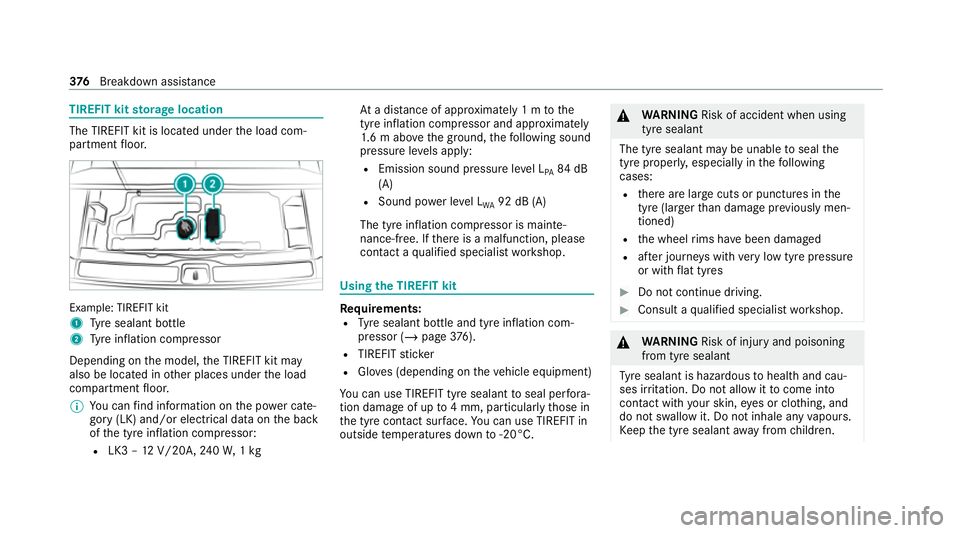
TIREFIT kit
storage location The TIREFIT kit is located under
the load com‐
partment floor. Example: TIREFIT kit
1
Tyre sealant bottle
2 Tyre inflation compressor
Depending on the model, the TIREFIT kit may
also be located in other places under the load
compartment floor.
% You can find information on the po wer cate‐
gory (LK) and/or electrical data on the back
of the tyre inflation compressor:
R LK3 – 12V/20A, 240W, 1kg At
a dis tance of appr oximately 1 m tothe
tyre inflation compressor and appr oximately
1. 6 m abo vethe ground, thefo llowing sound
pressure le vels apply:
R Emission sound pressure le vel L
PA 84
dB
(A)
R Sound po wer le vel L
WA 92 dB (A)
The tyre inflation compressor is mainte‐
nance-free. If there is a malfunction, please
conta ct aqualified specialist workshop. Using
the TIREFIT kit Re
quirements:
R Tyre sealant bottle and tyre inflation com‐
pressor (/ page376).
R TIREFIT sticker
R Gloves (depending on theve hicle equipment)
Yo u can use TIREFIT tyre sealant toseal per fora‐
tion dama geof up to4 mm, particularly those in
th e tyre conta ct surface. You can use TIREFIT in
outside temp eratures down to-20°C. &
WARNING Risk of accident when using
tyre sealant
The tyre sealant may be unable toseal the
tyre proper ly, especially in thefo llowing
cases:
R there are large cuts or punctures in the
tyre (larger than damage pr eviously men‐
tioned)
R the wheel rims ha vebeen damaged
R afte r journe yswith very low tyre pressure
or with flat tyres #
Do not continue driving. #
Consult a qualified specialist workshop. &
WARNING Risk of inju ryand poisoning
from tyre sealant
Ty re sealant is hazardous tohealth and cau‐
ses ir rita tion. Do not allow it tocome into
contact wi thyour skin, eyes or clo thing, and
do not swallow it. Do not inhale any vapours.
Ke ep the tyre sealant away from children. 376
Breakdown assis tance
Page 382 of 549
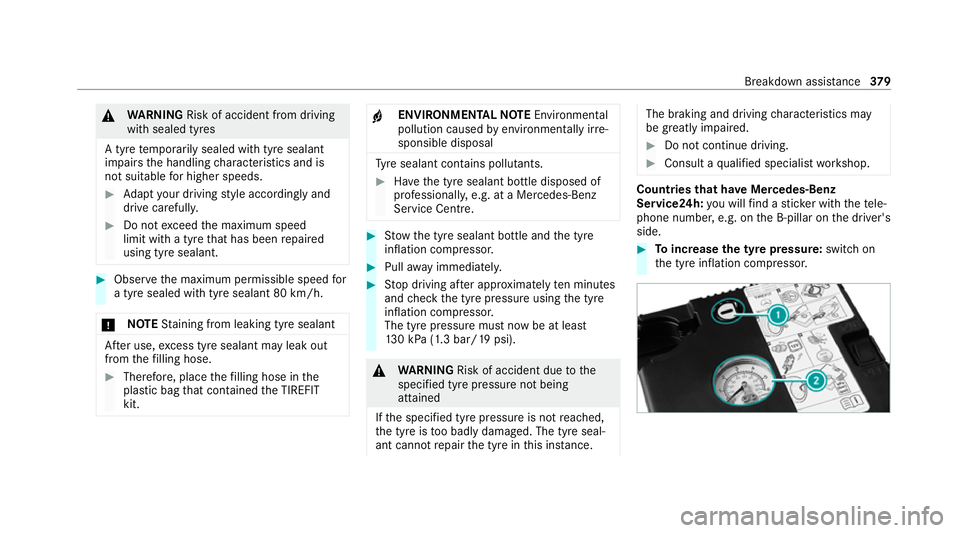
&
WARNING Risk of accident from driving
wi th sealed tyres
A tyre temp orarily sealed with tyre sealant
impairs the handling characteristics and is
not suitable for higher speeds. #
Adapt your driving style according lyand
drive carefull y. #
Do not exceed the maximum speed
limit with a tyre that has been repaired
using tyre sealant. #
Obser vethe maximum permissible speed for
a tyre sealed with tyre sealant 80 km/h.
* NO
TEStaining from leaking tyre sealant Af
ter use, excess tyre sealant may leak out
from thefilling hose. #
Therefore, place thefilling hose in the
plastic bag that con tained the TIREFIT
kit. +
ENVIRONMEN
TALNO TEEnvironmental
pollution caused byenvironmen tally ir re‐
sponsible disposal Ty
re sealant contains polluta nts. #
Have the tyre sealant bottle disposed of
professionall y,e.g. at a Mercedes-Benz
Service Centre. #
Stow th e tyre sealant bottle and the tyre
inflation compressor. #
Pull away immediatel y. #
Stop driving af ter appro ximately ten minu tes
and check the tyre pressure using the tyre
inflation compressor.
The tyre pressure must now be at least
13 0 kPa (1.3 bar/19 psi). &
WARNING Risk of accident due tothe
specified tyre pressure not being
attained
If th e specified tyre pressure is not reached,
th e tyre is too badly damaged. The tyre seal‐
ant cannot repair the tyre in this ins tance. The braking and driving
characteristics may
be great lyimpaired. #
Do not continue driving. #
Consult a qualified specialist workshop. Countries
that ha veMercedes-Benz
Service24h: you will find a sticke r with thete le‐
phone number, e.g. on the B‑pillar on the driver's
side. #
Toincrease the ty repressure: switch on
th e tyre inflation compressor. Breakdown assis
tance 37 9
Page 396 of 549

Note
s on noise or unusual handling charac‐
te rist ics
Make sure there are no vibrations, noises or
unusual handling characteristics when theve hi‐
cle is in motion. This may indicate that the
wheels or tyres are damaged. Hidden tyre dam‐
age could also be causing the unusual handling
ch aracteristics.
If yo u suspect that a tyre is defective, reduce
yo ur speed immediately and ha vethe tyres and
wheels checked at a qualified specialist work‐
shop. Note
s onregular lyinspecting wheels and
tyres &
WARNING Risk of inju rydue todamaged
tyres
Damaged tyres can cause tyre pressure loss. #
Check the tyres regularly for signs of
dama geand replace any damaged tyres
immediatel y. &
WARNING Risk of aquaplaning due to
insuf ficient tyre tread
Insu fficient tyre tread will result in reduced
tyre grip.
The risk of aquaplaning is increased on wet
ro ads, especially when the speed of theve hi‐
cle is not adap tedto suit the conditions. #
Thus, you should regularly check the
tread de pth and the condition of the
tread across the entire width of all
tyres.
Minimum tread dep thfor:
R Summer tyres: 3 mm
R M+S tyres: 4 mm #
For saf etyre asons, replace the tyres
before the legally-prescribed limit for
th e minimum tread dep thisreached. Car
ryout thefo llowing checks on all wheels reg‐
ularly, at least once a month or as requ ired, for
ex ample, prior toa long journey or driving off-
ro ad:
R Check the tyre pressure (/ page 394).
R Visually inspect wheels and tyres for dam‐
age.
R Check theva lve caps.
R Visual check of the tyre tread dep thand the
tyre contact su rface across the entire width.
The minimum tread dep thfor summer tyres
is 3 mm and for winter tyres 4 mm. Note
s on snow chains &
WARNING Risk of accident due toincor‐
re ct snow chain fitting
If yo u ha vefitted snow chains tothe front
wheels, the snow chains may drag against
th eve hicle body or chassis components.
This could cause damage totheve hicle or
th e tyres. Wheels and tyres
393
Page 402 of 549
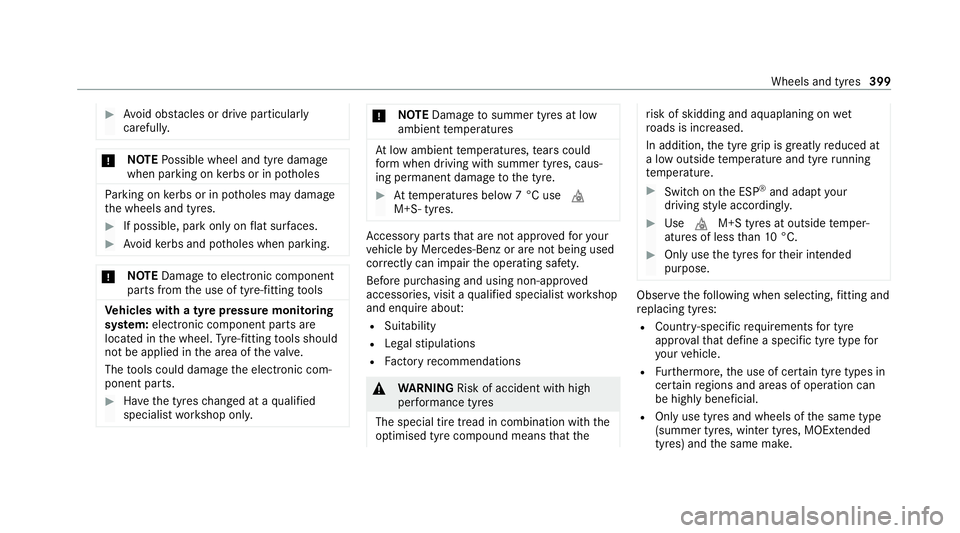
#
Avoid obs tacles or drive pa rticular ly
carefully. *
NO
TEPossible wheel and tyre damage
when parking on kerbs or in po tholes Pa
rking on kerbs or in po tholes may damage
th e wheels and tyres. #
If possible, park only on flat sur faces. #
Avoid kerbs and po tholes when parking. *
NO
TEDama getoelectronic component
parts from the use of tyre-fitting tools Ve
hicles with a tyre pressure monitoring
sy stem: electronic component parts are
located in the wheel. Tyre-fitting tools should
not be applied in the area of theva lve.
The tools could damage the electronic com‐
ponent parts. #
Have the tyres changed at a qualified
specialist workshop onl y. *
NO
TEDama getosummer tyres at low
ambient temp eratures At
low ambient temp eratures, tears could
fo rm when driving with summer tyres, caus‐
ing permanent damage tothe tyre. #
Attemp eratures below 7 °C use i
M+S- tyres. Ac
cessory pa rts th at are not appr ovedfo ryo ur
ve hicle byMercedes-Benz or are not being used
cor rectly can impair the operating saf ety.
Before pu rchasing and using non-appr oved
accesso ries, visit a qualified specialist workshop
and enquire about:
R Suitability
R Legal stipulations
R Factory recommendations &
WARNING Risk of accident wi thhigh
per form ance tyres
The special tire tread in combination with the
optimised tyre compound means that the ri
sk of skidding and aquaplaning on wet
ro ads is inc reased.
In addition, the tyre grip is greatly reduced at
a low outside temp erature and tyre running
te mp erature. #
Switch on the ESP ®
and adapt your
driving style accordingly. #
Use i M+S tyres at outside temp er‐
atures of less than 10 °C. #
Only use the tyres forth eir intended
purpose. Obser
vethefo llowing when selecting, fitting and
re placing tyres:
R Countr y-specific requirements for tyre
appro valth at define a specific tyre type for
yo ur vehicle.
R Furthermore, the use of cer tain tyre types in
cer tain regions and areas of operation can
be highly beneficial.
R Only use tyres and wheels of the same type
(summer tyres, winter tyres, MOEx tended
tyres) and the same make. Wheels and tyres
399
Page 403 of 549
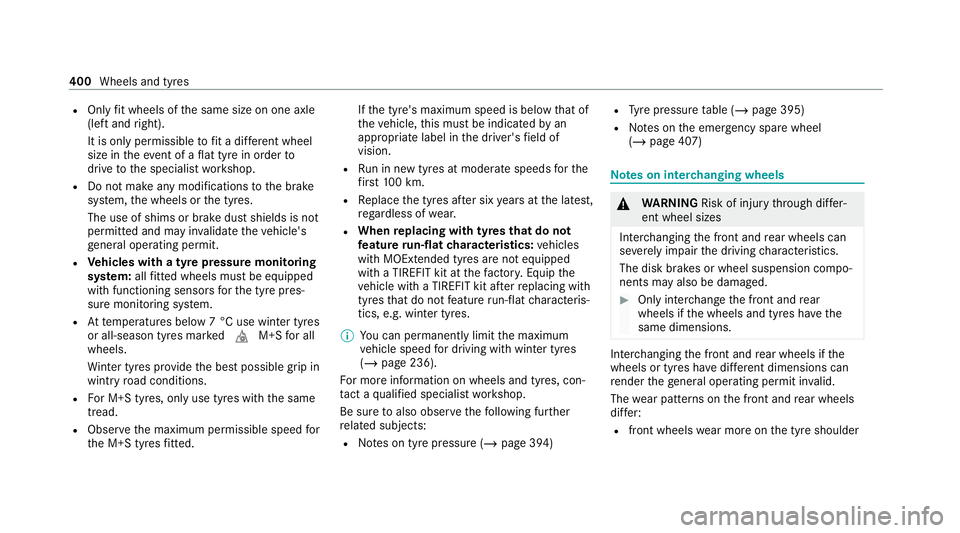
R
Only fit wheels of the same size on one axle
(left and right).
It is only permissible tofit a di fferent wheel
size in theeve nt of a flat tyre in order to
drive tothe specialist workshop.
R Do not make any modifications tothe brake
sy stem, the wheels or the tyres.
The use of shims or brake dust shields is not
permitted and may in validate theve hicle's
ge neral operating pe rmit.
R Vehicles with a tyre pressure monitoring
sy stem: allfitted wheels mu stbe equipped
with functioning sensors forth e tyre pres‐
sure monitoring sy stem.
R Attemp eratures below 7 °C use winter tyres
or all-season tyres mar kedi M+Sfor all
wheels.
Wi nter tyres pr ovide the best possible grip in
wintry road conditions.
R For M+S tyres, only use tyres with the same
tread.
R Obser vethe maximum permissible speed for
th e M+S tyres fitted. If
th e tyre's maximum speed is below that of
th eve hicle, this must be indicated byan
appropriate label in the driver's field of
vision.
R Run in new tyres at moderate speeds forthe
fi rs t10 0 km.
R Replace the tyres af ter six years at the latest,
re ga rdless of wear.
R When replacing with tyres that do not
fe ature run-flat characteristics: vehicles
with MOExtended tyres are not equipped
with a TIREFIT kit at thefa ctor y.Equip the
ve hicle with a TIREFIT kit af terre placing with
tyres that do not feature run-flat characteris‐
tics, e.g. winter tyres.
% You can permanently limit the maximum
ve hicle speed for driving with winter tyres
(/ page 236).
Fo r more information on wheels and tyres, con‐
ta ct a qualified specialist workshop.
Be sure toalso obse rveth efo llowing fur ther
re lated subjects:
R Notes on tyre pressure (/ page 394)R
Tyre pressure table (/ page 395)
R Notes on the emer gency spa rewheel
(/ page 407) Note
s on inter changing wheels &
WARNING Risk of inju rythro ugh dif fer‐
ent wheel sizes
Inter changing the front and rear wheels can
se verely impair the driving characteristics.
The disk brakes or wheel suspension compo‐
nents may also be damaged. #
Onlyinter change the front and rear
wheels if the wheels and tyres ha vethe
same dimensions. Inter
changing the front and rear wheels if the
wheels or tyres ha vediffere nt dimensions can
re nder thege neral operating pe rmit in valid.
The wear pat tern s on the front and rear wheels
dif fer:
R front wheels wear more on the tyre shoulder 400
Wheels and tyres
Page 540 of 549
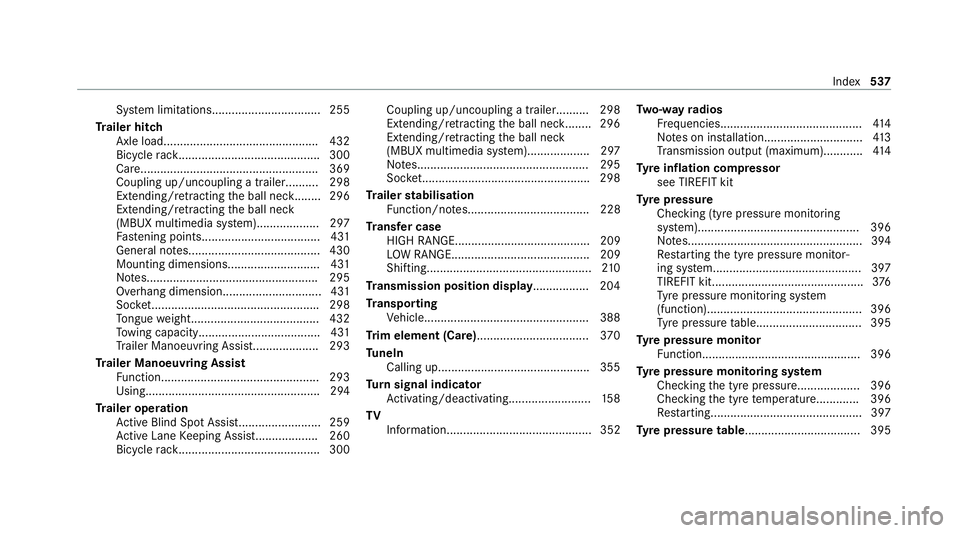
Sy
stem limitations................................. 255
Tr ailer hitch
Axle load.............................................. .432
Bicycle rack ........................................... 300
Ca re...................................................... 369
Coupling up/uncoupling a traile r.......... 298
Extending/r etra cting the ball nec k........ 296
Extending/r etra cting the ball neck
(MBUX multimedia sy stem)...................2 97
Fa stening points.................................... 431
General no tes........................................4 30
Mounting dimensions............................ 431
No tes....................................................2 95
Overhang dimension.............................. 431
Soc ket.................................................. .298
To ngue weight...................................... .432
To wing capacity.................................... .431
Tr ailer Manoeuv ring Assi st.................... 293
Tr ailer Manoeuvring Assist
Fu nction................................................ 293
Using..................................................... 294
Tr ailer operation
Ac tive Blind Spot Assi st......................... 259
Ac tive Lane Keeping Assist...................2 60
Bicycle rack ........................................... 300 Coupling up/uncoupling a traile
r.......... 298
Extending/r etra cting the ball nec k........ 296
Extending/r etra cting the ball neck
(MBUX multimedia sy stem)...................2 97
No tes....................................................2 95
Soc ket.................................................. .298
Tr ailer stabilisation
Fu nction/no tes..................................... 228
Tr ansfer case
HIGH RANGE......................................... 209
LO W RANGE.......................................... 209
Shifting..................................................2 10
Tr ansmission position display................. 204
Tr anspo rting
Ve hicle..................................................3 88
Tr im element (Care)................................. .370
Tu neIn
Calling up..............................................3 55
Tu rn signal indicator
Ac tivating/deactivating......................... 15 8
TV Information............................................ 352 Tw
o-w ayradios
Fr equencies........................................... 414
No tes on ins tallation.............................. 413
Tr ansmission output (maximum )............ 414
Ty re inflation compressor
see TIREFIT kit
Ty re pressure
Checking (ty repressure monitoring
sy stem)................................................. 396
No tes..................................................... 394
Re starting the tyre pressure monitor‐
ing sy stem.............................................3 97
TIREFIT kit..............................................3 76
Ty re pressure monitoring sy stem
(function)............................................... 396
Ty re pressure table................................ 395
Ty re pressure moni tor
Fu nction................................................ 396
Ty re pressure moni toring sy stem
Checking the tyre pressure...................3 96
Che cking the tyre temp erature............. 396
Re starting.............................................. 397
Ty re pressure table ................................... 395 Index
537
Page 541 of 549
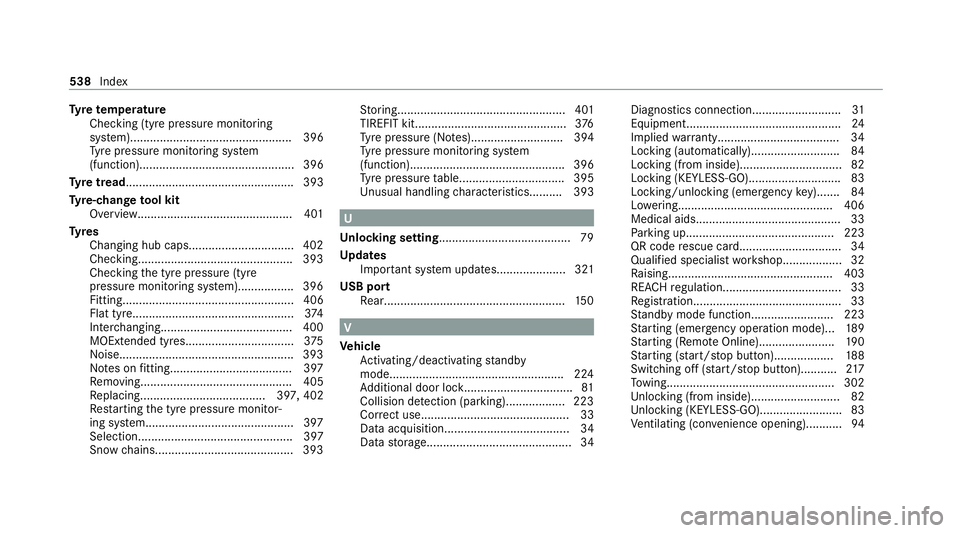
Ty
re temp erature
Checking (tyre pressure monitoring
sy stem)................................................. 396
Ty re pressure monitoring sy stem
(function)............................................... 396
Ty re tread ................................................... 393
Ty re-change tool kit
Overview............................................... 401
Ty res
Changing hub caps................................ 402
Checking............................................... 393
Checking the tyre pressure (tyre
pressure monitoring sy stem)................. 396
Fitting.................................................... 406
Flat tyre.................................................3 74
Inter changing........................................ 400
MOExtended tyres................................ .375
No ise.................................................... .393
No tes on fitting..................................... 397
Re moving.............................................. 405
Re placing...................................... 397, 402
Re starting the tyre pressure monitor‐
ing sy stem.............................................3 97
Selection............................................... 397
Snow chains.......................................... 393 St
oring................................................... 401
TIREFIT kit..............................................3 76
Ty re pressure (N otes)............................ 394
Ty re pressure monitoring sy stem
(function)............................................... 396
Ty re pressure table................................ 395
Un usual handling characteristic s.......... 393 U
Un locking setting ........................................ 79
Up dates
Impor tant sy stem updates..................... 321
USB port Rear...................................................... .150 V
Ve hicle
Ac tivating/deactivating standby
mode.................................................... .224
Ad ditional door loc k................................ .81
Collision de tection (pa rking).................. 223
Cor rect use............................................. 33
Data acquisition...................................... 34
Data storage............................................ 34 Diagnostics connection...........................
31
Equipment............................................... 24
Implied warrant y..................................... 34
Locking (automatically). ..........................84
Locking (from inside)...............................82
Locking (KEYLESS-GO)............................ 83
Locking/unlocking (emergency key)....... 84
Lo we ring............................................... 406
Medical aids............................................ 33
Pa rking up............................................ .223
QR code rescue card............................... 34
Qualifi ed specialist workshop.................. 32
Ra ising.................................................. 403
REA CHregulation.................................... 33
Re gistration............................................. 33
St andby mode function........................ .223
St arting (eme rgency operation mode).. .189
St arting (Remo teOnline).......................1 90
St arting (s tart/s top button).................. 188
Switching off (s tart/s top button)...........2 17
To wing.................................................. .302
Un locking (from inside).......................... .82
Un locking (KEYLESS-GO)........................ .83
Ve ntilating (co nvenience opening)........... 94538
Index